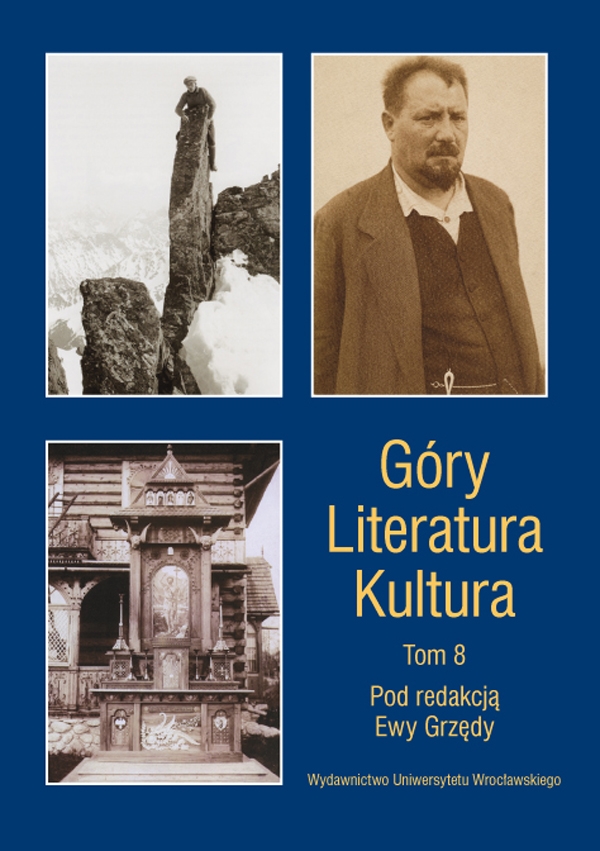

Artykuły

Jan Kasprowicz and the Zakopane style
It is by no means easy to present Jan Kasprowicz’s links to the Zakopane style, because Kasprowicz did not speak about the subject. Yet anybody visiting the museum dedicated to the poet in the Harenda villa will certainly note the Zakopane-style furniture — a dresser, clock, table and chairs in the dining room as well as a table and four chairs in room housing the exhibition of Władysław Jarocki’s paintings. The villa itself also represents an architectural form of a simplified Zakopane style or, more precisely, regional architecture from the Podhale region, which emerged under the influence of the Zakopane style.
Jan Kasprowicz was a leading representative of the Young Poland movement, the chronological framework of which corresponds almost exactly to the beginnings and development of the Zakopane style: 1890–1918. Kasprowicz came to Zakopane for the first time in July 1892 to spend his holidays there. This was exactly the time when the first Zakopane-style house, i.e. the Koliba villa, was being built. Another visit, in the summer of 1896, brought authentic friendship with Wojciech Brzega, a collaborator of the man who created the Zakopane style, Stanisław Witkiewicz. In 1898 the artists met again during Kasprowicz’s another summer visit to Zakopane.
1901 was marked by an exacerbation of the conflict over the Zakopane style, going on since the late 19th century, between the followers of Stanisław Witkiewicz and those of Edgar Kováts. This was caused by an exhibition of the oeuvre of the architect of the so-called Zakopane way. Kasprowicz sided with the followers of Witkiewicz, while Lviv architects sided with Kováts. He was also defended by his then student... Władysław Jarocki.
Kasprowicz was familiar with the style and Stanisław Witkiewicz’s role in its creation, which could be seen during the unveiling of the Tytus Chałubiński monument in Zakopane in 1903, when he spoke on behalf of young artists. On this occasion he had an opportunity to meet Stanisław Witkiewicz and Zygmunt Gnatowski, chair of the Monument Committee and owner of the Koliba villa. On 10 September the poet visited the villa and his visit was recorded by an entry — in the form of a poem written especially for the occasion — in the host’s guest book.
In 1903–1906 Kasprowicz frequently visited another promoter of the Zakopane style, the creator of the modern philosophy of nature conservation and owner of a flagship work of the Zakopane style — the “Pod Jedlami” house — Jan Gwalbert Pawlikowski. In 1906 the poet ordered Zakopane style furniture for his study in Poronin from Wojciech Brzega. This was during his extended stay in Stanisław Marduła Pawlica’s house. The architectural form of this building was an example of how Witkiewicz’s ideas influenced folk houses in the Podhale region. The furniture in question was later used in the library in the Harenda villa.
There is also a photograph taken in the poet’s Lviv fl at during Kazimierz Twardowski’s visit. In it, both gentlemen lie on a huge bed covered by a Zakopane-style bedspread, with a stylish stool standing next to it. After Kasprowicz’s third marriage, to young Marusia Bunin, which took place in September 1911 in Dresden, the newlyweds spent their honeymoon in Poronin, staying at Ludwina and Józef Marduła Gał’s, a house to which they kept returning in subsequent years. It, too, was a wooden house, erected by highland carpenters in the Witkiewicz style. Another, indirect link to the Zakopane style could be found in the fundraising for the construction of the Tatra Museum, Stanisław Witkiewicz’s last work.
In early 1923 the Kasprowiczs moved into Paweł Gut Mostowy’s pension in Poronin and later into Teresa Cudzich Skupień’s house in Biały Dunajec. Both buildings resembled Kasprowicz’s previous residences as well as well as his future villa in Harenda, which would be his own. The Harenda villa was built in 1920 by Jan Kluś Fudała and then bought by the English painter Winifred Cooper, from whom it was bought by Jan Kasprowicz in 1923. It housed the already mentioned library with Zakopane-style furniture. Less than two years after the purchase the poet died, on 1 August 1926.
In 1933 the artist’s ashes were moved from the old cemetery to a mausoleum designed by the first revisionist of the Zakopane style, Karol Stryjeński, co-author of the success of Polish decorative art at the World Fair in Paris. The Mausoleum is an outstanding example of art déco in Poland. This trend — called “the style of regained independence” — was also the last national style in Polish art and a continuation of the Zakopane style. Yet this is not the end of the symbolic links between Jan Kasprowicz and the Zakopane style. When in 1935 the heavily mortgaged Koliba villa was put up for auction, some of its furnishings — a dresser, 4 tables and 6 chairs were bought by... Władysław Jarocki, Kasprowicz’s son-in-law, old opponent of Witkiewicz and supporter of Kováts.
It could, therefore, be said that Jan Kasprowicz witnessed the birth of the Zakopane style from his very first visit to the region. Later, during the “dispute over the style,” he sided with Witkiewicz. There is no doubt that he liked to have Zakopane-style furniture around him, a fact evidenced by the furnishings of his successive flats: in Lviv, Poronin and, finally, his own house in Harenda. The poet’s earthly remains were put in a mausoleum which is an outstanding example of Polish decorative art, which represents the last Polish national style. Finally, after the poet’s death the first pieces of dining room furniture designed b y Witkiewicz found their way to Kasprowicz’s villa. This is the symbolic framework of the links between Jan Kasprowicz and the Zakopane style.